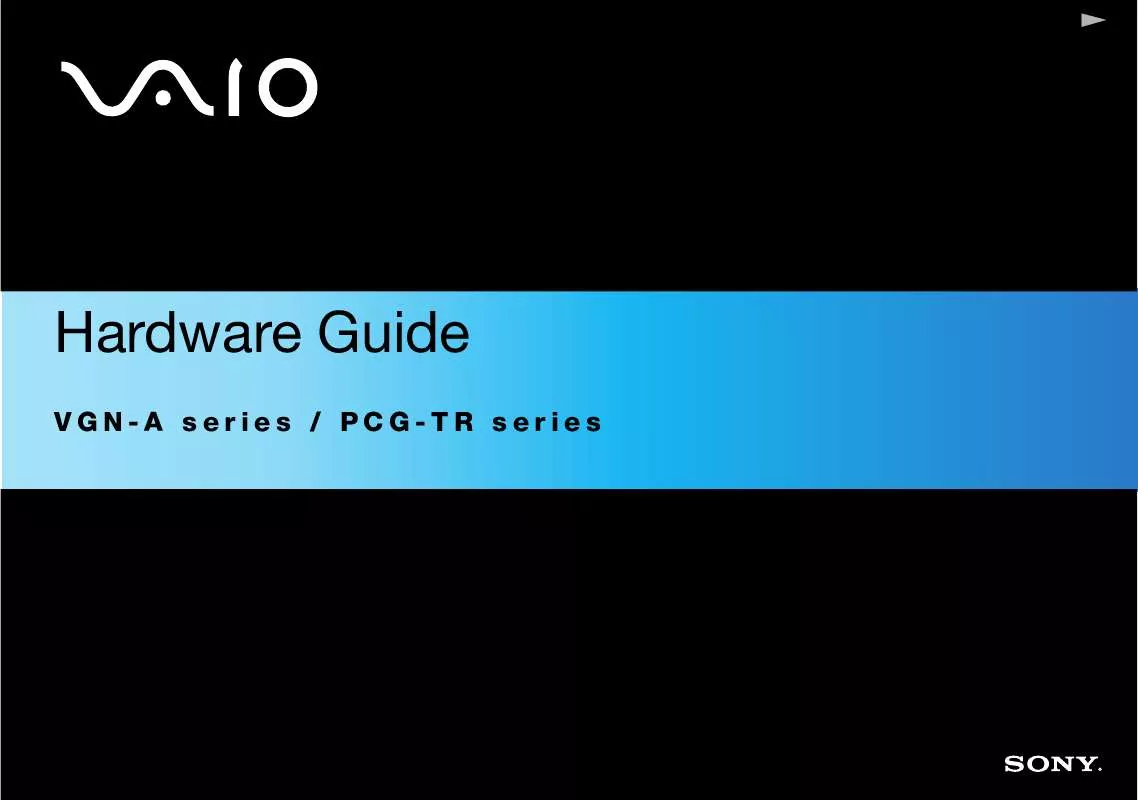User manual SONY VAIO PCG-TR5MP
Lastmanuals offers a socially driven service of sharing, storing and searching manuals related to use of hardware and software : user guide, owner's manual, quick start guide, technical datasheets... DON'T FORGET : ALWAYS READ THE USER GUIDE BEFORE BUYING !!!
If this document matches the user guide, instructions manual or user manual, feature sets, schematics you are looking for, download it now. Lastmanuals provides you a fast and easy access to the user manual SONY VAIO PCG-TR5MP. We hope that this SONY VAIO PCG-TR5MP user guide will be useful to you.
Lastmanuals help download the user guide SONY VAIO PCG-TR5MP.
You may also download the following manuals related to this product:
Manual abstract: user guide SONY VAIO PCG-TR5MP
Detailed instructions for use are in the User's Guide.
[. . . ] N
Hardware Guide
VGN-A series / PCG-TR series
nN
1 Hardware Guide Read this first
Read this first
Notice
© 2004 Sony Corporation. This manual and the software described herein, in whole or in part, may not be reproduced, translated, or reduced to any machine-readable form without prior written approval. Sony Corporation provides no warranty with regard to this manual, the software, or other information contained herein and hereby expressly disclaims any implied warranties or merchantability or fitness for any particular purpose with regard to this manual, the software or such other information. In no event shall Sony Corporation be liable for any incidental, consequential, or special damages, whether based on tort, contract, or otherwise, arising out of or in connection with this manual, the software, or other information contained herein or the use thereof. [. . . ] So there is no need anymore to pull cables or wires through walls and ceilings. The Sony WLAN supports all normal Ethernet activities, but with the added benefits of mobility and roaming. You can still access information, internet/intranet and network resources, even in the middle of a meeting, or as you move from one place to another. You can communicate without an Access Point, this means that you can communicate between a limited number of computers (ad-hoc), or you can communicate through an Access Point, which allows you to create a full infrastructure network (infrastructure).
* Depending on your model.
In some countries, using WLAN products may be restricted by the local regulations (e. g. Therefore, before activating the WLAN functionality, read the Wireless LAN Regulation leaflet carefully. Channel selection is explained further in this manual (see Wireless LAN channel selection (page 62)). WLAN uses the IEEE 802. 11b/g standard, which specifies the used technology. The standard includes the encryption method: Wired Equivalent Privacy (WEP), which is a security protocol and WiFi Protected Access (WPA - Proposed jointly by the IEEE and Wi-Fi Alliance, WiFi Protected Access is a specification of standards based, interoperable security enhancements that increase the level of data protection and access control for existing WiFi networks. WPA has been designed to be forward compatible with the IEEE 802. 11i specification. It utilizes the enhanced data encryption TKIP (Temporal Key Integrity Protocol) in addition to user authentication using 802. 1X and EAP (Extensible Authentication Protocol)). Data encryption protects the vulnerable wireless link between clients and Access Points. Besides that, there are other typical LAN security mechanisms to ensure privacy, such as: password protection, end-to-end encryption, virtual private networks, and authentication. Wireless LAN devices using the IEEE 802. 11a standard and the ones using the IEEE 802. 11b or g standard cannot communicate because the frequencies are different. Wireless LAN devices using the IEEE 802. 11g standard can only communicate with a device using the IEEE 802. 11b standard, not with the a standard. IEEE 802. 11b: The standard speed is 11 Mbps, or about 30 to 100 times faster than a standard dial up. IEEE 802. 11g: The standard speed is 54 Mbps, or about 5 times faster than a Wireless LAN device using the IEEE 802. 11b standard.
nN
56 Hardware Guide Using your VAIO computer
Communicating without Access Point (ad-hoc)
An ad-hoc network is a network in which a local network is created only by the wireless devices themselves, with no other central controller or Access Point. Each device communicates directly with other devices in the network. You can set up an ad-hoc network easily at home.
To communicate without Access Point (ad-hoc), proceed as follows: 1 Turn on the Wireless LAN switch. If your notebook supports Bluetooth, the Switch wireless devices dialog box appears. The Wireless switch button changes into Wireless LAN. Double-click the network icon in the taskbar displaying Wireless Network Connection. The Connect to Wireless Network dialog box appears. [. . . ] It may create a traffic hazard and is illegal in some areas. It can also be potentially dangerous to play loud music while walking, especially at pedestrian crossings. Preventing hearing damage Avoid using headphones at high volume. Hearing experts advise against continuous, loud and extended play. [. . . ]
DISCLAIMER TO DOWNLOAD THE USER GUIDE SONY VAIO PCG-TR5MP Lastmanuals offers a socially driven service of sharing, storing and searching manuals related to use of hardware and software : user guide, owner's manual, quick start guide, technical datasheets...manual SONY VAIO PCG-TR5MP


 SONY VAIO PCG-TR5MP SOFTWARE MANUAL (778 ko)
SONY VAIO PCG-TR5MP SOFTWARE MANUAL (778 ko)
